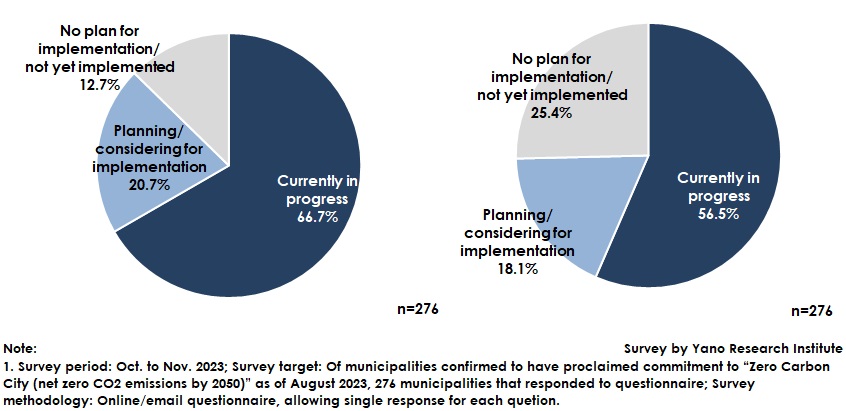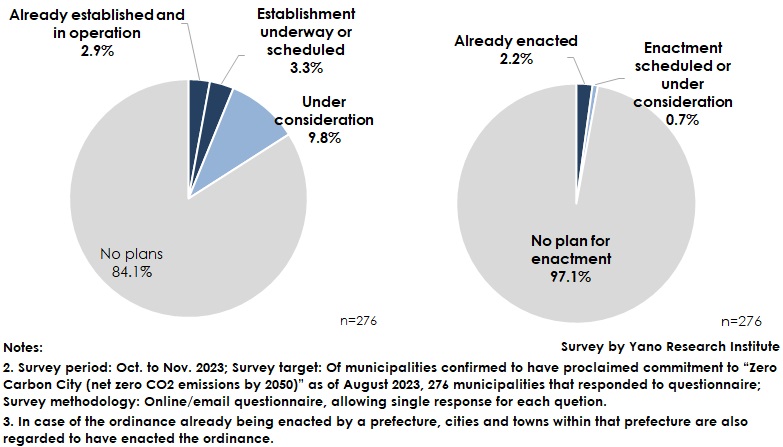No.3443
Questionnaire to Municipalities on Zero Carbon City Realization in Japan: Key Research Findings 2023
Renewable Energy Equipment/Storage Batteries Augmented to Realize Zero Carbon Cities
Yano Research Institute (the President, Takashi Mizukoshi) has conducted a questionnaire to 973 municipalities proclaiming to realize “Zero Carbon City (net zero CO2 emissions by 2050)” as of August 2023 with the cooperations of K.K. Kyodo News and analyzed the status and challenges of municipal measures. Here discloses the aggregated results on 276 cities and towns as a part of the survey.


Summary of Research Findings
This questionnaire was conducted with the cooperation of K.K. Kyodo News to 973 local governments that were confirmed to have announced their commitment to net zero carbon emissions by 2050 (as of August 2023). Here shows status and challenges that municipalities face to realize net zero carbon cities from the aggregated responses by 276 cities and towns.
When asked to municipalities on the status of taking measures to pervade renewable energy equipment including solar panels and on expanding deployment of residential and industrial storage batteries, more than 80% of municipalities showed their intentions of implementing the former, and more than 70% for the latter, according to respective total numbers of responses for “currently underway” and “planning/considering for implementation”. This stems from improved resilience to natural disasters (*1) and challenges against grid power limitations and output suppression.
In exchange for increased power volume from renewables, grid power limitations have come to occur due to lack of transmission line capacity in the areas with traditionally low electricity demand. In such areas, it is difficult to feed power back to utility grids no matter how steadily renewable equipment is installed. In a clear day when power volume increases from solar power, some hours in a day see increase in excess electricity, which requires output to be suppressed for consistent supply and demand of electricity. Such output suppression cases have occurred in Kyushu area augmented with PV power installations due to good access to sunlight, and in other areas as well in recent years.
As a measure against grid power limitations and output suppression, a method of increasing self-consumption of power by demanders with renewable equipment has gathered attention. It is effective to store the excess power generated in daytime in storage battery and use it in nighttime when power demand increases. The questionnaire results show that municipalities have intentions to increase the effectiveness of deploying renewable equipment such as by encouraging storage batteries for using up the power from renewable sources without waste.
*1) Improved resilience to natural disaster: Here indicates continued availability of energy by power demanders that may be public facilities or general households, etc. even when a natural disaster causes power outage by securing an emergency power source. This can be attained by utilizing renewable equipment and storage batteries.
Noteworthy Topics
Trend of Community Microgrids and Significance of Mandating Renewable Equipment
A community microgrid is a system designed to maintain electricity infrastructure within the community when large-scale disaster causes power outage by switching to standalone mode from main grid. As an autonomous power source, it secures PV generation equipment and/or storage batteries to enable power consumption from renewable sources without waste during the normal period. By establishing a self-sufficient electricity mechanism, it is considered to attain both improved resilience to natural disaster and decarbonization.
When asked about the community microgrid establishment status in the questionnaire, however, municipalities that showed positive attitude in it accounted only for less than 20%. The reasons were necessity to gain consent among residents, equipment owners and operators, and difficulty in utilizing existing transmission lines especially in the area with power grid limitations, and additional costs needed if installing a new line instead.
As an alternative solution to community microgrid and for electricity coverage for specific areas, house-to-house efforts for the resilience improvement and decarbonization may work. Because, to increase the number of households equipped with solar panels or a storage battery can be the smallest disaster prevention function of a community-based measure, which enables to cover in-house electricity demand and can be highly effective.
In April 2025, Tokyo, and Kawasaki City of Kanagawa Prefecture plan to enact an ordinance to mandate newly built homes to deploy renewable power equipment. According to the questionnaire on the enactment status for the ordinance (*2), municipalities positive for enactment remain at a few percent. Although use of power purchase agreements (PPAs) (*3) that do not require investment for setting up the equipment is increasing, the awareness is not sufficient. Concerns over expanding costs seem to be preventing municipalities from enacting the ordinance. Therefore, it is necessary to urge deeper understanding in promoting renewable energy equipment through deployment support & incentives, while also necessary to show local communities on how the equipment contributes to the communities, such as improved resilience and decarbonization.
*2) In case of the ordinance already being enacted by a prefecture, cities and towns within that prefecture are also regarded to have enacted the ordinance.
*3) A Power Purchase Agreement (PPA) refers to a long-term electricity supply agreement between two parties, usually between a power producer and a demander. Power producers with renewable energy sources conclude PPAs with power demanders thereby to install renewable energy facilities without any front-end investments needed, in principle, as they charge for electricity and service fees to power demanders for a certain period.
Research Outline
2.Research Object: 296 local governments (20 prefectures and 276 municipalities) that have expressed their intentions to achieve Zero Carbon City (net zero CO2 emissions by 2050) as of the end of August 2023
3.Research Methogology: Questionnaire via internet or email
About Questionnaire to Municipalities on Measures to Realize “Zero Carbon City”
This questionnaire was conducted with the cooperation of K.K. Kyodo News to 973 municipalities that, as of 31 August 2023, announced to being “Zero Carbon City (net zero CO2 emissions by 2050)”. Based on the results, we analyzed the status and challenges of municipal measures on this matter. Here discloses the aggregated results on 276 cities and towns as a part of the survey.
<Products and Services in the Market>
Measures by governments for renewable energy diffusion and for energy-saving promotions
Published Report
Contact Us
The copyright and all other rights pertaining to this report belong to Yano Research Institute.
Please contact our PR team when quoting the report contents for the purpose other than media coverage.
Depending on the purpose of using our report, we may ask you to present your sentences for confirmation beforehand.